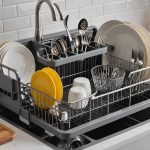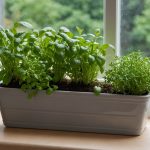Window Sill Wonders: Your Ultimate Guide to Growing a Thriving Herb Garden in Miniature Greens
Growing an herb garden on your windowsill is a great way to bring a touch of nature and freshness into your home, and it’s easier than you might think. Here’s a comprehensive guide to help you get started and ensure your herbs thrive year-round.
Choosing the Right Herbs for Your Indoor Garden
When it comes to selecting herbs for your indoor garden, it’s important to choose varieties that are well-suited for indoor conditions and can thrive in partial shade or full sun, depending on your window’s exposure.
Also to read : Unleashing the benefits: transform your kitchen design with recycled materials
Popular Herbs for Indoor Growing
Here are some of the best herbs to grow indoors:
- Basil: A classic choice, basil loves warm temperatures and plenty of sunlight. It’s a bit more finicky but worth the effort for its delicious flavor.
- Mint: Mint is incredibly hardy and can grow in partial shade. It’s also known for its ability to spread quickly, so consider containing it to prevent it from taking over.
- Chives: Chives are easy to grow and require minimal care. They prefer well-draining soil and partial shade to full sun.
- Parsley: Parsley is a slow-growing herb that prefers partial shade and consistent moisture.
- Thyme: Thyme is another low-maintenance herb that can thrive in indoor conditions with minimal sunlight.
- Rosemary: While rosemary prefers full sun, it can still do well in a bright, sunny windowsill. It requires well-draining soil to prevent root rot.
Preparing the Perfect Soil for Your Herbs
The soil you use for your herb garden is crucial for the health and growth of your plants. Here are some tips to prepare the best soil for your herbs:
Also to read : Ultimate kitchen wellness: your comprehensive guide to effortlessly installing a water filtration system
Key Components of Herb Garden Soil
- Well-Draining Soil: Herbs hate wet feet, so ensuring your soil drains well is essential. A mix of potting soil, perlite, and vermiculite can help achieve this.
- Organic Matter: Adding compost or organic fertilizer can enrich the soil and provide nutrients to your herbs.
- pH Balance: Most herbs prefer a slightly acidic to neutral soil pH, ranging from 6.0 to 7.0.
| Soil Component | Description |
|---|---|
| Potting Soil | Provides the base structure for the soil |
| Perlite | Improves drainage and aeration |
| Vermiculite | Retains moisture but allows for good drainage |
| Compost | Adds nutrients and improves soil structure |
| Organic Fertilizer | Provides slow-release nutrients |
Setting Up Your Windowsill Herb Garden
Setting up your herb garden on the windowsill involves a few key steps to ensure your plants receive the right conditions.
Selecting the Right Containers
Choose containers that are at least 6-8 inches deep to give the roots of your herbs enough room to grow. Make sure the containers have drainage holes to prevent waterlogged soil.
Positioning Your Herbs
- Sunlight: Place your herbs in a spot that receives the right amount of sunlight. For example, basil and rosemary need full sun, while parsley and thyme can do well in partial shade.
- Air Circulation: Ensure good air circulation around your plants to prevent fungal diseases. Keep them at least a few inches away from the window frame.
Watering Your Herbs
Watering is one of the most critical aspects of growing herbs indoors. Here are some tips:
- Check the Soil: Before watering, stick your finger into the soil up to the first knuckle. If the soil feels dry, it’s time to water.
- Water Thoroughly: Water your herbs until you see water coming out of the drainage holes.
- Avoid Overwatering: Herbs are prone to root rot if the soil is too wet. Make sure the soil has a chance to dry out slightly between waterings.
Maintaining Your Herb Garden
Maintaining your herb garden involves regular care and attention to ensure your herbs continue to thrive.
Fertilizing Your Herbs
- Use Organic Fertilizers: Feed your herbs with a balanced, water-soluble organic fertilizer once a week.
- Compost Tea: You can also use compost tea as a natural fertilizer. It’s made by steeping compost in water and then using the liquid as a fertilizer.
Pruning and Harvesting
- Prune Regularly: Pruning your herbs regularly encourages bushy growth and prevents them from flowering. Pinch off flower buds as they form.
- Harvest Correctly: Harvest your herbs in the morning after the dew has dried but before the heat of the day. Use scissors or pinch off individual leaves to avoid damaging the plant.
Common Challenges and Solutions
Growing herbs indoors can come with some challenges, but there are solutions to each of these issues.
Root Rot
- Cause: Overwatering is the most common cause of root rot.
- Solution: Check the soil regularly, and ensure it has a chance to dry out slightly between waterings. Improve drainage by adding more perlite or vermiculite to the soil.
Pests
- Cause: Indoor pests like spider mites, mealybugs, and aphids can infest your herbs.
- Solution: Inspect your plants regularly. Use neem oil or insecticidal soap to treat infestations. Isolate infected plants to prevent the pests from spreading.
Lack of Sunlight
- Cause: If your window doesn’t receive enough sunlight, your herbs may not thrive.
- Solution: Consider using grow lights to supplement natural sunlight. LED grow lights are energy-efficient and can provide the spectrum of light your herbs need.
Tips for Year-Round Growing
To keep your herb garden thriving year-round, here are some additional tips:
Seasonal Care
- Winter: Reduce watering and fertilizing during the winter months when herbs grow more slowly.
- Summer: Increase watering and fertilizing during the summer months when herbs are in their active growth phase.
Propagation
- Seeds: Start new herbs from seeds in the spring or fall. Use a seed starting mix and keep the soil consistently moist until germination.
- Cuttings: Propagate herbs like mint, basil, and rosemary using cuttings. Take 4-6 inch stem cuttings, remove lower leaves, and plant them in well-draining soil.
Growing an herb garden on your windowsill is a rewarding and easy way to bring fresh herbs into your kitchen year-round. By choosing the right herbs, preparing the perfect soil, setting up your garden correctly, and maintaining it with regular care, you can enjoy a thriving and fragrant herb garden right in your home.
As gardening expert Nicolas Fourmentin from Rustica notes, “Les plantes d’intérieur sont une excellente façon de rappeler la nature et de faciliter le bien-être et la relaxation dans votre maison.”[1]
With the right knowledge and a little care, your windowsill can become a lush oasis of fresh herbs, ready to enhance any meal and brighten up your space. Happy gardening











